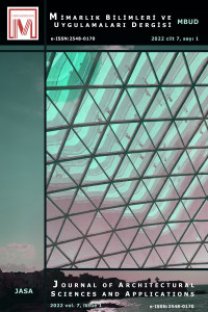Güneş Enerjisiyle Havadan İçilebilir Su Elde Edebilen Yazılım ve Donanım Destekli bir Sistem Önerisi
Su döngüsü, içilebilir su, yoğuşma, çiğ noktası, güneş enerjisi, termoelektrik soğutma
A Software and Hardware Supported System Suggestion for Obtaining Potable Water from Air with Solar Energy
Water cycle, potable water, condensation, dew point, solar energy, thermoelectric cooling,
___
- Alenezi, A., Jung, H. & Alabaiadly, Y. (2023). Experimental and numerical analysis of an atmospheric water harvester using a thermoelectric cooler. Journal Atmosphere, Vol. 14.
- Avhad, S., Dandekar, A., Chandak, A., Kajale, P. & Gohel, N. S. (2021). Theoretical Analysis of Atmospheric Water Generator using Thermoelectric Cooler. The International Conference on Emerging Trends in Engineering, Yukthi 2021.
- Balkrishan. Gupta, A., Chand, S., Patel, N. K. & Soni, A. (2016). A review on thermoelectric cooler. International Journal for Innovative Research in Science & Technology, Vol. 2.
- Bhushan, B. (2020). Design of Water Harvesting Towers and Projections for Water Collection From Fog and Condensation. Philosophical Transactions of The Royal Society A Mathematical Physical and Engineering Sciences, March 2020.
- Booth, D. B. (1991). Urbanization and the natural drainage system impacts, solutions and prognoses. The Northwest Environmental Journal, Vol. 7, No 1.
- Eslami, M., Tajeddini, F. & Etaati, N. (2018). Thermal analysis and optimization of a system for water harvesting from humid air using thermoelectric coolers. Energy Conversion and Management, Vol. 174, 15 October 2018, p. 417-429.
- Faqih, A. (2005). Production of Potable Water and Freshwater Needs for Human, Animal and Plants from Hot and Humid Air. USA Patent Document: US6868690B2.
- Heidari, H., Arabi, M., Warziniack, T. & Sharvelle, S. (2021). Effects of Urban Development Patterns on Municipal Water Shortage. Frontiers in Water, Vol. 3.
- Kadhim, T. J., Abbas, A. K. & Kadhim H. J. (2020). Experimental study of atmospheric water collection powered by solar energy using the Peltier effect. IOP Conference Series: Materials Science and Engineering, Vol. 671.
- Liu, S., He, W., Hu, D., Lv, S., Chen, D., Wu, X., Xu, F. & Li, S. (2017). Experimental analysis of a portable atmospheric water generator by thermoelectric cooling method. Energies, Vol. 13.
- Maleki, M., Eslamian, S. & Hamouda, B. (2021). Handbook of Water Harvesting and Conservation: Basic Concepts and Fundamentals. Wiley, 1st edition (March 1, 2021), p. 245-257 (Chp. 16).
- Max, M. D. (2005). Apparatus and Method For Harvesting Atmospherıc Moisture. USA Patent Document: US6945063B2.
- Özcan, G., Çelebi, N. & Arpacıoğlu, Ü. (2022). Portable irrigation system producing water from air for sustainable living. Journal of Architectural Sciences and Applications, 2022, 7 (2), 501-510.
- Pamuk, R. & Kuruoğlu, M. (2016). İnşaat sektöründe sürdürülebilirlik ve bina inşaatlarında evrensel uygulama örnekleri. Beykent University Journal of Science and Engineering Sciences, Vol. 9, p. 161-177.
- Parameter Generation & Control. (2019). How to Use a Psychrometric Chart. Access address (05.06.2023): https://humiditycontrol.com/psychrometric-chart/.
- Pouya, S., Türkoğlu, H. & Arpacıoğlu, Ü. (2020). Using the analytic hierarchy process to evaluate sustainability factors in watershed planning and management. Urbani Izziv-Urban Challenge, Vol. 31.
- Reidy, J. J. (2008). Thermoelectric, High-Efficiency Water Generating Device. USA Patent Document: US7337615B2.
- Seydim, Z. B., Greene, A. K. & Seydim, A. C. (2004). Use of ozone in the food industry. LWT-Food Science and Technology, Vol. 37, June 2004, p. 453-460.
- Shiklomanov, I. A. (2009). Appraisal and assessment of world water resources. Water International, Vol. 25, p. 11- 32.
- The Engineering Tool Box. (2023). Air-maximum moisture carrying capacity, Access address (05.06.2023):https://www.engineeringtoolbox.com/maximum-moisture-content-air-d_1403.html
- Verbrugghe, N. & Khan, A. Z. (2023). Water Harvesting Through Fog Collectors: a Review of Conceptual, Experimental and Operational Aspects. International Journal of Low-Carbon Technologies, Vol. 18.
- Wada, Y., Beek, L., Wanders N. & Bierkens, M. (2013). Human water consumption ıntensifies hydrological drought worldwide. Environmental Research Letters, Vol. 8, No 3.
- World Health Organization. (2017). Guidelines for Drinking-Water Quality. Access address (05.06.2023): https://www.who.int/publications/i/item/9789241549950
- Yang, P., Clark, D. S. & Yaghi, O. M. (2021). Envisioning the “Air Economy”-powered by reticular chemistry and sunlight for clean air, clean energy and clean water. Molecular Frontiers Journal, Vol. 05, No. 01n02, p. 30-37.
- Yayın Aralığı: 2
- Başlangıç: 2016
- Yayıncı: Atila GÜL
Sümeyye GENCER, Elif AKPINAR KÜLEKÇİ
Antalya Yivli Minare (Mevlevihane) Hamamı Üzerine Bir Restitüsyon Önerisi
Endüstri Arkeolojisini Koruma Yöntemlerinin İncelenmesi: Beykoz Deri ve Kundura Fabrikası Örneği
Ahmet KURNAZ, Zeynep KEREM ÖZTÜRK
Ampirik Termal Konfor Değerlendirme Yöntemlerinin Bulanık Mantıkla Zenginleştirilmesi
Okul Bahçelerinde Açık Hava Sınıfı Tasarımı Üzerine Bir Araştırma
Elif ŞATIROĞLU, Selda AL ŞENSOY, Abdullah Yasin DÜNDAR
Ibrahim Halil HATİPOGLU, Hatice TOSYAGÜLÜ ÇELİK, Ömer Faruk KAYA
Saliha TÜRKMENOĞLU BERKAN, Saniye KARAMAN ÖZTAŞ
Kent Tarımına İlişkin Paydaş Görüşleri: Iğdır Örneği
Enes AKDENİZ, M. Bihter BİNGÜL BULUT, İbrahim HOSAFLIOĞLU, Öner DEMİREL
Hatıra Peyzajlarının Evrimi: Gelibolu Tarihi Alanı’ndaki Anma Mekanlarının Analizi
Göreme Saklı Kilise Özelinde Kaya Oyma Kiliselerinde Koruma Girişimleri/Değerlendirmeleri
